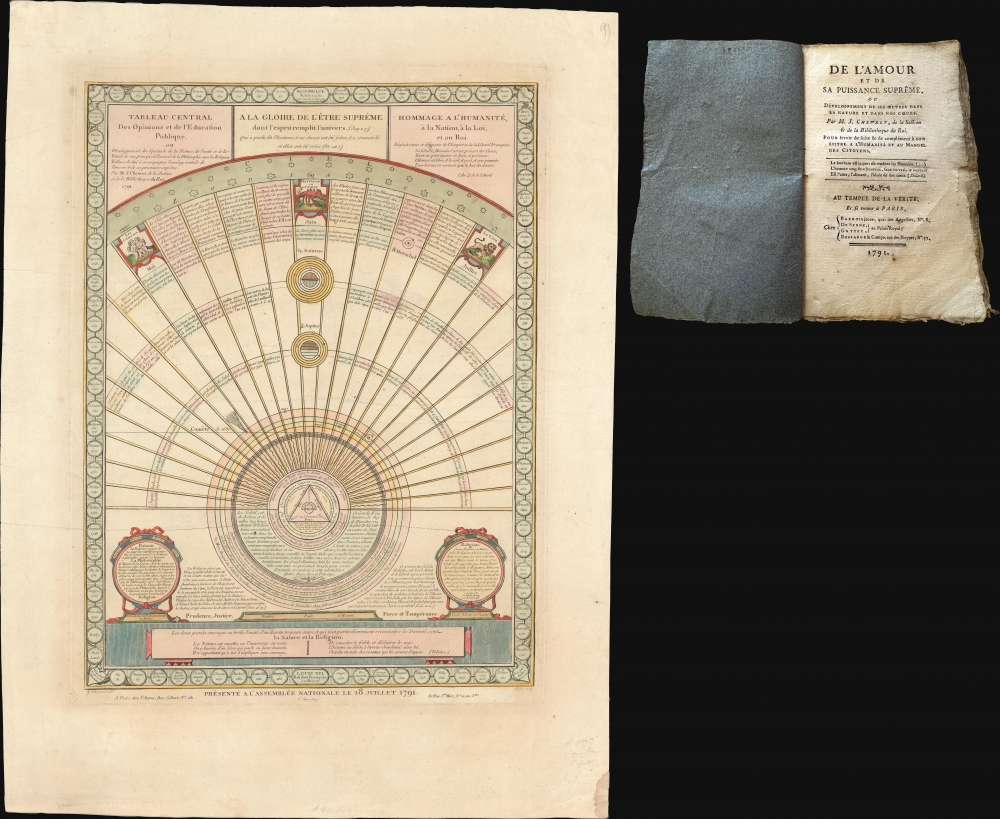1791 Jean Chevret Diagram and Treatise on a New Religion for Revolutionary France
TableauCentral-chevret-1791
Title
1791 (dated) 21.75 x 15.75 in (55.245 x 40.005 cm)
Description
A Closer Look
The cosmogram takes the form of a celestial map, situating humanity within the context of the greater cosmos. It centered around god (Dieu), represented in a Catholic-inspired trinity: Father (Pere), Son (Fils), and Holy Ghost (Esprit). God is associated with the Sun, from which light and wisdom radiate. Orbiting the God/Sun are the planets: Mercury, Venus, Earth (and Moon), Mars, Jupiter (4, with moons), Saturn (5, with moons), and Uranus - here named after its 1781 discoverer, the great English astronomer William Herschel. Even the Great Comet of 1680 (Kirch's Comet or Newton's Comet) is illustrated. Beyond is the celestial sphere, or Zodiac, where Gemini (Mai), Cancer (Juin), and Leo (Juillet) are illustrated. These are surrounded by and interspaced with copious text explaining the interrelation of Reason, Philosophy, and Religion, including quotations from Enlightenment luminaries and scripture, as well as scientific facts and mystical ideas.The Sum of Human Experience
Jean Chevret's Tableau central des opinions et de l’éducation publique is an ambitious philosophical and educational framework created to accompany his metaphysical treatise De l'Amour et de sa Puissance Supreme, as presented before the Assemblée Nationale on July 18, 1791. Intended as both a visual map of human understanding and a tool for moral instruction, the Tableau attempts to unify nature, reason, and divine revelation within a single harmonious system. Throughout, New Testament quotations are linked to astronomical calculations and the ideas of Newton, Descartes, Voltaire, and others. Drawing on Enlightenment rationalism, Christian theology, and mystical traditions, Chevret presents a vision in which the 'unity and trinity' of the universe's principles reflect both cosmic order and theological truth. The chart outlines the relationship between human faculties - such as reason, will, and emotion - and divine law, emphasizing the role of public education in cultivating not only intellectual development but also moral and spiritual elevation. Part encyclopedic schema, part spiritual cosmogram, the Tableau tries to reconcile philosophy with religion and to present knowledge as an interconnected system governed by universal principles.Publication History and Census
This diagram was produced by Jean Chevret in Paris in 1791. It was engraved by Jean-Baptiste Marie Poisson and Charles Picquet. The diagram and the accompanying treatise were submitted before the Revolutionary Assemblée Nationale on July 18, 1791. Examples were also sold at shops throughout Paris. Today, it is extremely rare, with fewer than 3 examples known. There is a confirmed example at the Carnavalet Museum, Paris. The Bibliothèque nationale de France digital asset has been populated throughout OCLC, but this does not appear to represent a physical holding.CartographerS
Jean Chevret (March 15, 1747 - August 5, 1820) was a French librarian, moralist, and philosopher active during the French Revolution (1789 - 1799) and Napoleonic Era (1799 - 1815). Chevret was born in Meulan, France. In 1765, he served as a librarian at the Bibliothèque du Roi (Bibliothèque Nationale, post-Revolution). His philosophical thought focused on the exploration of metaphysical themes related to the divine dimensions of love, offering a synthesis of religious doctrine and French Enlightenment rationalism. More particularly, he focused on the relationship between nature, religion, love, and education. In 1791, Chevret presented before the National Assembly a religio-philosophical-metaphysical model for a new religion that embodied the ideals of the French Revolution, but despite some support, it was never formally adopted. More by this mapmaker...
Charles Picquet (April 15, 1771 – January 15, 1827) was a French cartographer active in Paris during the Napoleonic and post-Napoleonic Eras. Picquet was born in Romagna-sous-Montfaucon, Meuse, France. From about 1798 Picquet supplied maps to the Dépôt de la Guerre. From 1806 he was appointed to Napoleon's Cabinet Topographique. Being politically dexterous, he was able to retain this position after the fall of Napoleon under both Louis XVIII and Charles X. Under Louis XVIII he also obtained the Brevet de Géographe Ordinaire du Cabinet Topographique. He worked with the cartographer Adrien-Hubert Brué on a major atlas project. When Charles Picquet died in 1827, his son, Pierre-Jacques Picquet, continued to publish under his father's imprint name well into the middle part of the 19th century. Learn More...
Jean-Baptiste Marie Poisson (fl. c. 17xx - 17xx) was a French engraver active in Paris during and before the French Revolution (1789 - 1799). Although reasonably prolific, his life is otherwise opaque. Learn More...

